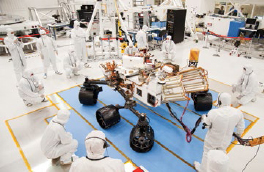2012
Mars Science Laboratory Curiosity Rover
More than 40 years of up-close exploration of Mars by orbiters, landers, and rovers has provided fascinating and compelling evidence that, by most accounts, the Red Planet was more Earthlike and more potentially habitable long ago than it is today. That evidence has come in many forms, including ancient river valley landscapes carved by liquid water flowing on the surface, and deposits of specific kinds of hydrated minerals that could only have formed in a more watery environment.
The Viking landers in the 1970s performed sensitive searches for organic molecules on Mars but came up empty, partly because their geologically boring landing sites had to be chosen before much was known about Mars’s watery past. With the benefit of hindsight and an additional 35 years of study, NASA decided to search for traces of organic molecules, and potentially, past life, with a new Mars rover mission. Thus, in 2006, the Mars Science Laboratory rover mission was initiated, with a landing targeted at ancient sedimentary rocks in Gale crater, where liquid water and energy sources—two key requirements for life—are known to have existed based on the geology and mineralogy determined from orbit.

Technicians exercise the wheels of NASA’s Mars Science Laboratory rover, named Curiosity, during initial driving tests at the Jet Propulsion Laboratory in July 2010.
The rover, called Curiosity, landed safely on Mars on August 6, 2012. It’s about three times the size of the Mars rovers Spirit and Opportunity, and it carries an impressive payload: high-resolution color stereo cameras and a color microscope, a laser spectrometer to zap rocks and measure their composition, an X-ray instrument to identify minerals, and a very sensitive mass spectrometer to locate organic molecules in soil and rock samples.
Curiosity quickly discovered evidence of flowing surface water, as well as water-formed clay minerals, in Gale crater. As of 2018, the rover has started climbing the slopes of Mt. Sharp, searching for even more evidence of the Red Planet’s watery past.
SEE ALSO Mars (4.5 Billion BCE), Mars and Its Canals (1906), First Mars Orbiters (1971), Vikings on Mars (1976), Life on Mars? (1996), First Rover on Mars (1997), Mars Global Surveyor (1997), Spirit and Opportunity on Mars (2004).
NASA’s Curiosity Mars rover took this “selfie” using its arm-mounted camera in 2016, while parked next to a dark sand dune and vein-filled outcrop rocks. The rover’s 16-inch (40 centimeters) wide wheels were used to dig into the sand for detailed study at this location.
